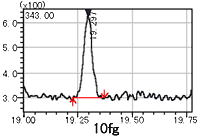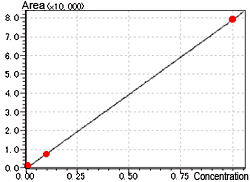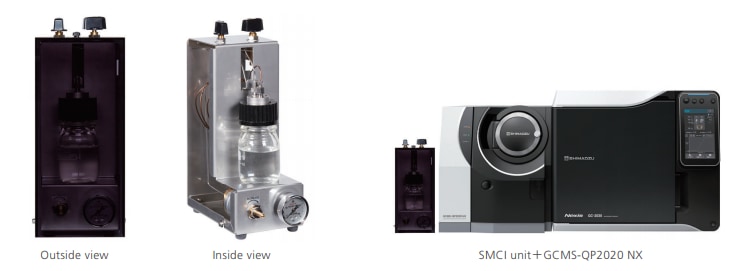
10 fg ß-Estradiol (SIM)
When analyzing mass spectra, first molecular ions are determined. Then, once molecular ions are determined, the subsequent data analysis is easy. However, when using electron ionization (EI), in some cases no molecular ions are detected or they are difficult to confirm due to relatively weak intensity. In contrast, since CI is a softer ionization method than EI, fragmentation is less likely to occur, so information about molecular weight is more readily obtained.
Because the GCMS-QP2020 can measure a broad mass range, up to a maximum m/z value of 1090, it can easily measure molecular ions even for components with large molecular weights, such as TMS derivatives of saccharose (see below).

TMS Derivatives of Saccharose (mass spectra of C36H86O11Si8at MW = 918)
Molecular weight ions (+NH4) can be detected using CI, even when they cannot be detected using EI.
Environmental analysis requires measuring ultra-trace amounts of chemical substances such as endocrine disruptors. Highly toxic pollutants contain large numbers of chlorine-based compounds, such as persistent organic pollutants (POPs), which are monitored according to the Stockholm Convention. NCI is ideal for quantitating trace quantities of such compounds. Even for compounds without electron affinity, such as estradiol, electron affinity can be introduced using derivatization to enable highly sensitive measurement by NCI.

10 fg ß-Estradiol (SIM)

Calibration Curve for 10 fg to 1 pg

PFB and TMS Derivatization of ß-Estradiol

SMCI stands for Solvent Mediated Chemical Ionization, a soft ionization method for GCMS. The headspace reagent gas from the sample bottle is introduced into the GCMS ionization unit to be ionized, which then causes chemical ionization (CI) of the target molecule via protonation*. Previous CI methods have required the use of flammable reagent gas cylinders, but SMCI can be carried out with a general organic solvent such as methanol or acetonitrile, together with nitrogen or argon gas. This results in greater safety and lower running costs.
*Patent pending